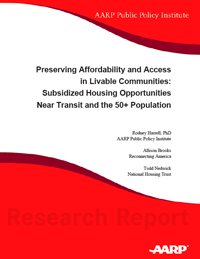Study by AARP, Reconnecting America and National Housing Trust explores impact of expiration of contracts for federally subsidized units
 In the next five years as many as 160,000 renters in 20 metro areas could lose their affordable apartments near transit because the contracts on their privately-owned HUD-subsidized rental units are due to expire. The renewed popularity of urban living means that properties in walkable neighborhoods near transit have increased in value, and that property owners are likely to opt out of the HUD program and convert the housing from affordable to market rate.
In the next five years as many as 160,000 renters in 20 metro areas could lose their affordable apartments near transit because the contracts on their privately-owned HUD-subsidized rental units are due to expire. The renewed popularity of urban living means that properties in walkable neighborhoods near transit have increased in value, and that property owners are likely to opt out of the HUD program and convert the housing from affordable to market rate.
These are the results of a recent study by AARP, Reconnecting America and the National Housing Trust, which released the results in Washington, DC, on Sept. 30. The study found that there are more than 250,000 privately owned HUD-subsidized units within a half-mile of existing or proposed rail stations in the 20 regions, and that contracts on two-thirds of these units are due to expire by the end of 2014. Almost a quarter of the units are designated for seniors.
“Affordable housing near public transportation is a very special resource because families who use transit can reduce their transportation expenditures by 16 percent – so these subsidized apartments are made even more affordable because of their location,” noted Reconnecting America President and CEO John Robert Smith. “The federal government should ensure that this housing remains affordable.”